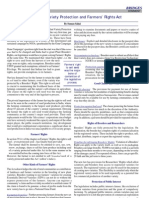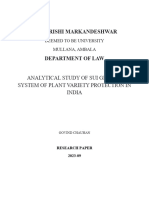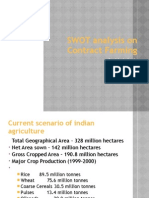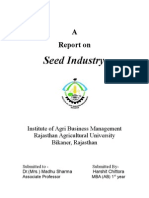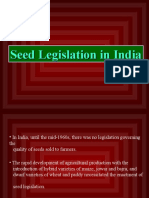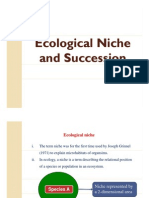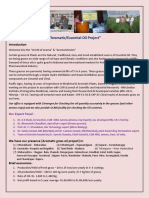Polity Current Affairs Round-Up 365 Module: Draft Seeds Bill 2019
Polity Current Affairs Round-Up 365 Module: Draft Seeds Bill 2019
Uploaded by
Chetan MitraCopyright:
Available Formats
Polity Current Affairs Round-Up 365 Module: Draft Seeds Bill 2019
Polity Current Affairs Round-Up 365 Module: Draft Seeds Bill 2019
Uploaded by
Chetan MitraOriginal Title
Copyright
Available Formats
Share this document
Did you find this document useful?
Is this content inappropriate?
Copyright:
Available Formats
Polity Current Affairs Round-Up 365 Module: Draft Seeds Bill 2019
Polity Current Affairs Round-Up 365 Module: Draft Seeds Bill 2019
Uploaded by
Chetan MitraCopyright:
Available Formats
P a g e |1
Polity Current Affairs
Round-up 365 Module:
Draft Seeds Bill 2019
By
Jatin Verma
©Jatin Verma All Rights Reserved. https://www.jatinverma.org
P a g e |2
Draft Seeds Bill 2019
Context:
The Seeds Bill 2019 was under Parliament’s consideration during the ongoing winter session.
• The government has invited public feedback on the recently released draft Seeds Bill 2019.
Governance over Seed Industry:
The seed industry has been governed by the
• Seed Act (1966),
• Seed Rules (1968),
• Seed (Control) Order (1983)
• New Policy on Seed Development (1988),
• Plants, Fruits & Seeds (Regulation of Import into India), 1989
• The PPV & FR Act (2001),
• The Essential Commodities Act including Seeds (1955) and National Seed Policy (2002),
• All aimed at supplying quality seeds and planting material to the farmer.
• The Seed Bill (2004) was proposed to replace the Seed Act (1966), however, owing to several
shortcomings, it was never passed.
Need of the Seed Bill 2019:
To make Indian legislation in line with International Conventions and Agreement on
Seeds Use.
The Protection of Plant Varieties and Farmers’ Rights (PPVFR) Act of 2001 could not
recognize all the provisions of the Convention and Agreement that India signed.
©Jatin Verma All Rights Reserved. https://www.jatinverma.org
P a g e |3
6. To specify standards for the registration of seed varieties
7. To enforce registration from seed producers to seed retailers.
8. More than 50% of India’s seed production is undertaken in the private sector.
9. The various versions between 2004 and 2019, private sector interests have guided the
formulation of the Seeds Bill.
10. Private seeds Companies force farmers to purchase the seeds from their outlet through the
lucrative advertisements.
11. To avoid Litigations: In the recent PepsiCo Vs. the Farmers of Gujarat Controversy, the
court spells out rights of farmers vis-a-vis breeders, which resulted in a pushback for
PepsiCo.
The Protection of Plant Varieties and Farmers’ Rights (PPVFR) Act of 2001
● India joined the World Trade Organisation in 1995 and agreed to implement the
Agreement on Trade Related Aspects of Intellectual Property Rights (TRIPS).
● On account of India's commitment, PPVFRA was enacted in 2001 for introducing
intellectual property rights in Indian agriculture.
● The choice before India was to either enact a law that protected the interests of farming
communities,
(or)
● To accept the framework of plant breeders’ rights given by the International Union for
Protection of New Plant Varieties (better known by its French acronym, UPOV Convention).
● The latter option was rejected primarily because the current version of UPOV, which was
adopted in 1991 (UPOV ’91).
● (ISSUE: It denies the farmers the freedom to re-use farm saved seeds and to exchange
them with their neighbours.)
©Jatin Verma All Rights Reserved. https://www.jatinverma.org
P a g e |4
● So India enacted The Protection of Plant Varieties and Farmers’ Rights (PPVFR) Act of
2001 which retained the main spirit of TRIPS also had strong provisions to protect
farmers’ rights.
KEY Provisions
● The Act provides for the establishment of an effective system for the protection of plant
varieties, the rights of farmers and plant breeders.
● The Act encourages the development of new varieties of plants it has been considered
necessary to recognize.
● It protects the rights of the farmers in respect of their contributions made at any time in
conserving, improving and making available plant genetic resources for the development of
new plant varieties.
● The PPVFR Act retained the main spirit of Trade Related Aspects of Intellectual Property
Rights (TRIPS) viz., IPRs as an incentive for technological innovation.
● It recognised three roles for the farmer: cultivator, breeder and conserver.
As cultivators, farmers were entitled to plant-back rights.
As breeders, farmers were held equivalent to plant breeders.
As conservers, farmers were entitled to rewards from a National Gene Fund.
• Solved the issue in UPOV Convention
Farmers are “entitled to save, use, sow, resow, exchange, share or sell his farm produce including
seed of a variety protected under this Act in the same manner as he was entitled before the
coming into force of this Act”
Key Provisions of the Draft Seeds Bill 2019 :
1.Replacement of old act:
• It aims to replace the Seeds Act, 1966 and regulate the quality of seeds sold.
2.Formation of Seed Committee:
• It authorizes the Central government to reconstitute a Central Seed Committee that will be
responsible for the effective implementation of its provisions.
3.Registration of Seed Varieties:
• All varieties of seeds for sale have to be registered.
• These seeds are required to meet certain prescribed minimum standards.
4.Declaration of the Performance of the Seeds:
• Breeders would be required to disclose the “expected performance” of their registered
varieties “under given conditions”.
©Jatin Verma All Rights Reserved. https://www.jatinverma.org
P a g e |5
5.Compensation to Farmers:
If the seed of such registered kind or variety “fails to provide the expected performance under
such given conditions”,
Eligible for
Compensation
the farmer “may claim compensation from the
producer, dealer, distributor or vendor under
The Consumer Protection Act, 1986”.
Limitations:
1.The provisions are mute on Certified seeds although it has higher and more stable yields than
farm-saved seeds.
2.The compulsory registration of seeds may lead to confusion:
Reason? as many seeds may be registered under the Seeds Bill but may not under the PPVFR
Act (voluntary registration).
3.Ever-greening” provision :
Private seed companies can re-register their seeds an infinite number of times after the
validity period.
©Jatin Verma All Rights Reserved. https://www.jatinverma.org
P a g e |6
4.This “ever-greening” provision may lead to a situation where many seed varieties may never
enter the open domain for free use
5.It does not demand information related to the complete passport data of the parental lines
from which the seed variety was derived.
6. The definition of transgenic variety is not clear and also unscientific.
Way-Forward:
1. There should be a shift from farm-saved seeds to certified seeds, which would raise seed
replacement rates.
2. An enabling atmosphere is required to achieve such shift rather than a stand-alone policy.
3. The monopoly of Private seed companies, who forces farmers to buy their seeds every
season, must go away.
4. The strong Public agricultural research systems should be institutionalized.
5. Seed price must be affordable to the farmers. The regulation should have the Provisions
related to the Seed price Control.
6. Opening new Agriculture institutions and promotion of seed-research at university level.
7. Enlisting the services of private firms for evaluating new varieties before seed registration.
8. The National Seed Association of India (NSAI) need to suggest a more scientific definition
of transgenic variety of Seeds.
9. The government should learn the lessons of the recent Shetkari Sanghatana ‘civil
disobedience’ protest which led the Monsanto to withdraw one of its most advanced GM
offerings from approval.
Conclusion
• India has one of the most progressive PPVFRA laws in the world.
• The Seed Bill 2019 is an opportunity for our lawmakers to set another precedent in the
world.
• The Key concerns of the farmers must be addressed.
• A deliberate discussion with all the stakeholders, prior to the passage of the bill, will
provide better insights.
The case of Bt cotton: THE INDIAN EXPERIENCE
Context:
• The interests of the cotton seed industry have constrained the very much larger value of
cotton production and the overall cotton industry.
Background:
• Genetically Modified (GM) pest resistant Bt cotton hybrids have captured the Indian market
since their introduction in 2002.
©Jatin Verma All Rights Reserved. https://www.jatinverma.org
P a g e |7
• These now cover over 95% of the area under cotton, with the seeds produced entirely by the
private sector.
• India’s cotton production in 2019 is projected as the highest ever - 354 lakh bales.
• However, Bt cotton hybrids have negatively impacted livelihoods and contributed to
agrarian distress, particularly among resource-poor farmers.
The Indian experience:
• This year, India is expected to be the world’s largest cotton producer, surpassing China in
output.
• However, India’s productivity (yield per unit area), is much lower than other major cotton-
producing countries, meaning a much larger area is used for cotton production.
• India is the only country that grows cotton as hybrids and the first to develop hybrid cotton
back in 1970.
• Though hybrid cottonseed production is expensive, requiring manual crossing, India’s low
cost of manual labour make it economically viable.
• All other cotton-producing countries grow cotton not as hybrids but varieties for which seeds
are produced by self-fertilization.
Cotton planting strategies
• For over three decades, most countries have been growing cotton varieties that are compact
and short duration.
• These varieties are planted at high density (5 kg seeds/acre),
• whereas hybrids in India are bushy, long duration and planted at ten-fold lower density (0.5
kg seeds/acre).
• Cotton is a dryland crop and 65% of area under cotton in India is rain-fed.
• Farmers with insufficient access to groundwater in these areas are entirely dependent on rain.
• Here, the shorter duration variety has a major advantage as it reduces dependence on
irrigation and risk, particularly late in the growing season when soil moisture drops following
the monsoon’s withdrawal.
• The advantages of compact varieties over hybrids are considerable:
More than twice the productivity,
Half the fertilizer (200 kg/ha for hybrids versus 100 kg/ha for varieties),
Reduced water requirement, and
Less vulnerability to damage from insect pests due to a shorter field duration.
• Yet, India has persisted with long-duration hybrids, many years after benefits of compact
varieties became clear from global experience.
Impact of policy: Two phases of policy
• The first is before GM cotton, when India persisted with hybrids from 1980-2002,
• While other countries shifted to HDP. (Missed Opportunity for India)
©Jatin Verma All Rights Reserved. https://www.jatinverma.org
P a g e |8
• The second phase where the question of hybrids versus compact varieties could have been
considered at the stage of GM regulation when Bt cotton was being evaluated for
introduction into India.
• But The scope of evaluation by the GM regulatory process in India was narrow, and did not
take this into account.
• Consequently, commercial Bt hybrids have completely taken over the market, accompanied
by withdrawal of public sector cotton seed production.
• The Indian cotton farmer today is left with little choice but to use Bt hybrid seed produced by
private seed companies.
Farmer distress
• The current annual value of cottonseed used for planting is about ₹2,500 crore, and that of
lint cotton produced is ₹68,000 crore.
• Therefore, it appears that the interests of the cotton seed industry have constrained the very
much larger value of cotton production and the overall cotton industry.
• Agricultural distress is extremely high among cotton farmers and the combination of high
input and high risk has likely been a contributing factor.
Policy Failure & its consequence
• Compact varieties would have significantly reduced distress as well as increased yield.
• Therefore, the hybrid seed model for cotton that India, and India alone, has followed for over
three decades, is inferior to the HDP model being used in other countries on three important
counts:
Much lower productivity,
Higher input costs, and
Increased risk particularly for low resource farmers in rainfed areas.
Takeaways from the experience of Bt cotton worldwide:`
• the outcome of using a technology such as Bt is determined by the context in which it is
deployed, and not just by the technology itself.
• Some of the major cotton-producing countries such as Brazil (until 2012) and Turkey (up to
the present) have achieved high productivity without the use of GM cotton by using
alternative pest-management approaches.
Mains question
DO YOU THINK THE NEW SEEDS BILL IS TILTED AGAINST FARMERS’
INTERESTS AND FAVOURs SEED COMPANIES? Discuss.
©Jatin Verma All Rights Reserved. https://www.jatinverma.org
P a g e |9
Important Facts related to this issues
• The Agreement on Trade-Related Aspects of Intellectual Property Rights (TRIPS) is
an international legal agreement between all the member nations of the World Trade
Organization (WTO).
• It sets down minimum standards for the regulation by national governments of many
forms of intellectual property (IP) as applied to nationals of other WTO member nations.
• TRIPS was negotiated at the end of the Uruguay Round of the General Agreement on
Tariffs and Trade (GATT) in 1994 and is administered by the WTO.
• The TRIPS agreement introduced intellectual property law into the international trading
system for the first time and remains the most comprehensive international agreement on
intellectual property to date.
What is TRIPS Plus?
• TRIPs Plus are higher level of protection norms demanded by the developed countries that
are not prescribed by the WTO’s TRIPs regime.
• Although they are named as ‘TRIPS-Plus,’ they are not formally related to TRIPs.
• Rather, the term is used to indicate that these requirements go beyond the minimum
standards imposed by TRIPs.
• Many developing countries who are members of FTAs are under pressure to enact these
tougher conditions in their patent laws.
UPOV Convention:
• The International Union for the Protection of New Varieties of Plants (UPOV) is an
intergovernmental organization with headquarters in Geneva (Switzerland).
• UPOV was established by the International Convention for the Protection of New Varieties
of Plants.
• The Convention was adopted in Paris in 1961 and it was revised in 1972, 1978 and 1991.
• UPOV's aim is to encourage the development of new varieties of plants, for the benefit of
society.
• The UPOV Convention provides the basis for members to encourage plant breeding by
granting breeders of new plant varieties an intellectual property right
• In the case of a variety protected by a breeder's right, the authorization of the breeder is
required to propagate the variety for commercial purposes.
• The breeder's right is granted by the individual UPOV members.
• Only the breeder of a new plant variety can protect that new plant variety. It is not
permitted for someone other than the breeder to obtain protection of a variety.
• Under the UPOV system a breeder might be an individual, a farmer, a researcher, a public
institute, a private company etc.
• India is not a member.
©Jatin Verma All Rights Reserved. https://www.jatinverma.org
P a g e | 10
• 195 UN states and the European Union are parties to the convention.
• All UN member states, with the exception of the United States, have ratified the treaty.
• At the 2010 10th Conference of Parties (COP) to the Convention on Biological Diversity in
October in Nagoya, Japan, the Nagoya Protocol was adopted.
Cartagena Protocol
• CBD covers the rapidly expanding field of biotechnology through its Cartagena Protocol
on Biosafety.
• It addresses technology development and transfer, benefit-sharing and biosafety issues.
• The Biosafety Protocol seeks to protect biological diversity from the potential risks posed
by living modified organisms resulting from modern biotechnology.
Nagoya Protocol
• It is the second Protocol to the CBD; the first is the 2000 Cartagena Protocol on Biosafety.
• It is a 2010 supplementary agreement to the 1992 Convention on Biological Diversity
(CBD).
• The Nagoya Protocol is about “Access to Genetic Resources and the Fair and Equitable
Sharing of Benefits Arising from their Utilization”, one of the three objectives of the
CBD.
The International Treaty on Plant Genetic Resources for Food and Agriculture
• It was adopted by the Thirty-First Session of the Conference of the Food and Agriculture
Organization of the United Nations on 3 November 2001.
©Jatin Verma All Rights Reserved. https://www.jatinverma.org
P a g e | 11
The Treaty aims at:
• Recognizing the enormous contribution of farmers to the diversity of crops that feed the
world.
• Establishing a global system to provide farmers, plant breeders and scientists with access to
plant genetic materials;
• Ensuring that recipients share benefits they derive from the use of these genetic materials
with the countries where they have been originated.
Main Provisions:
Multilateral system
• The Treaty’s puts 64 of our most important crops (crops that together account for 80 percent
of the food we derive from plants) into an easily accessible global pool of genetic resources
that is freely available to potential users in the Treaty’s ratifying nations for some uses.
Access and benefit sharing
• The Treaty facilitates access to the genetic materials of the 64 crops in the Multilateral
System for research, breeding and training for food and agriculture.
• Those who access the materials must be from the Treaty’s ratifying nations and they must
agree to use the materials totally for research, breeding and training for food and
agriculture.
• The Treaty prevents the recipients of genetic resources from claiming intellectual property
rights over those resources in the form in which they received them.
Farmers’ rights:
• The Treaty recognizes the enormous contribution farmers have made to the ongoing
development of the world’s wealth of plant genetic resources.
• It calls for protecting the traditional knowledge of these farmers, increasing their
participation in national decision-making processes and ensuring that they share in the
benefits from the use of these resources
Sustainable use:
• Most of the world’s food comes from four main crops – rice, wheat, maize and potatoes.
• However, local crops, not among the main four, are a major food source for hundreds of
millions of people and have potential to provide nutrition to countless others.
• The Treaty helps maximize the use and breeding of all crops and promotes development and
maintenance of diverse farming systems.
©Jatin Verma All Rights Reserved. https://www.jatinverma.org
You might also like
- Training Manual PDFDocument13 pagesTraining Manual PDFFitiwi Gnigus100% (2)
- Post Graduate Diploma in Public Accounting: Programmes Recognised by Ugc DebDocument14 pagesPost Graduate Diploma in Public Accounting: Programmes Recognised by Ugc DebChetan MitraNo ratings yet
- Minimum Wage - PhilippinesDocument7 pagesMinimum Wage - PhilippinesInhenyero TsupiteroNo ratings yet
- Highlights of The Seed Bill-2019Document4 pagesHighlights of The Seed Bill-2019Gargi UpadhyayaNo ratings yet
- Indian Agriculture Current Affairs - May 2019Document6 pagesIndian Agriculture Current Affairs - May 2019SyedNo ratings yet
- Mod 3 Farmers Rights in IndiaDocument25 pagesMod 3 Farmers Rights in IndiaShivam AggarwalNo ratings yet
- Insights Into Editorial Seed Bill Must Serve Farmers Not MNCsDocument4 pagesInsights Into Editorial Seed Bill Must Serve Farmers Not MNCsrishabh shahNo ratings yet
- Law and Agriculture PresentationDocument16 pagesLaw and Agriculture PresentationTulika GuptaNo ratings yet
- Important Provisions Regarding The Protection of Plant Varieties and Farmers Rights Act, 2001Document13 pagesImportant Provisions Regarding The Protection of Plant Varieties and Farmers Rights Act, 2001jerome143No ratings yet
- Seeds Bill-Complete AnalysisDocument8 pagesSeeds Bill-Complete AnalysisBabuNo ratings yet
- Protection of Plant Variety and Farmer'S Right - A Jurisprudential Analysis in Relation With OwnershipDocument21 pagesProtection of Plant Variety and Farmer'S Right - A Jurisprudential Analysis in Relation With OwnershipsandysamarthaNo ratings yet
- Am X - The Protection of Plant Varieties and Farmers' Rights ACT, 2001Document6 pagesAm X - The Protection of Plant Varieties and Farmers' Rights ACT, 2001shreyanshiNo ratings yet
- Seed Bill 2010: An Analytic ViewDocument19 pagesSeed Bill 2010: An Analytic ViewJashi RoyNo ratings yet
- Brief PPV&FR ActDocument6 pagesBrief PPV&FR Actsd100% (1)
- Understanding of The Farmers' Privilege Concept by Smallholder Farmers in South AfricaDocument5 pagesUnderstanding of The Farmers' Privilege Concept by Smallholder Farmers in South AfricaSaket RaoNo ratings yet
- Sahai Bridges Year 5 N8 Oct 2001Document2 pagesSahai Bridges Year 5 N8 Oct 2001Gopal NarkhedeNo ratings yet
- Plant Varieties in IPRDocument31 pagesPlant Varieties in IPRmerlin234No ratings yet
- What Rights Are Guranteed Under Protection of Plants Varities and Farmers ActDocument10 pagesWhat Rights Are Guranteed Under Protection of Plants Varities and Farmers Actpshubham65_551720227No ratings yet
- Contract Farming in India: Questions Covered in This TopicDocument5 pagesContract Farming in India: Questions Covered in This TopicShweta SinghNo ratings yet
- Plant Variety Protection Made EasyDocument215 pagesPlant Variety Protection Made Easyaryankhan57647No ratings yet
- Seed PolicyDocument5 pagesSeed PolicyJhalakNo ratings yet
- Govind Chauhan Reseach PaperDocument10 pagesGovind Chauhan Reseach PaperGovind RanaNo ratings yet
- Participatory Plant BreedingDocument12 pagesParticipatory Plant BreedingPrachi SinghNo ratings yet
- The Protection of Plant Varieties and Farmer'S Rights Act, 2001Document62 pagesThe Protection of Plant Varieties and Farmer'S Rights Act, 2001Ashi GautamNo ratings yet
- SWOT Analysis On Contract FarmingDocument29 pagesSWOT Analysis On Contract FarmingsachinNo ratings yet
- PPV&FR 070908Document10 pagesPPV&FR 070908LakshmipriyaNo ratings yet
- Plant Varieties Appellate TribunalDocument9 pagesPlant Varieties Appellate Tribunalnavoditakm04No ratings yet
- Sui Generis IPR Laws Vis-À-Vis Farmers' Rights in Some Asian CountriesDocument10 pagesSui Generis IPR Laws Vis-À-Vis Farmers' Rights in Some Asian CountriesShivam AggarwalNo ratings yet
- SEARICE UPR PHL S13 2012 S.E.a SoutheastAsialInitiativesforCommunityEmpowerment EDocument5 pagesSEARICE UPR PHL S13 2012 S.E.a SoutheastAsialInitiativesforCommunityEmpowerment EApril Rose Flores FloresNo ratings yet
- Contract FarmingDocument16 pagesContract FarmingNivedhaNo ratings yet
- Plant VarietyDocument4 pagesPlant VarietyMuskan KhatriNo ratings yet
- RA 7308 Hand OutDocument2 pagesRA 7308 Hand OutAmberChanNo ratings yet
- Upov R F - An Indian Perspective: AND Ights OF ArmersDocument4 pagesUpov R F - An Indian Perspective: AND Ights OF ArmersyashNo ratings yet
- Contractfarmingarticle 2 7Document6 pagesContractfarmingarticle 2 7nishidangi0No ratings yet
- Fasal Bima Yojana & New Agricultural Policy 2020Document4 pagesFasal Bima Yojana & New Agricultural Policy 2020Anju tpNo ratings yet
- 10-11. Plant Breeder’s Rights ad disadDocument20 pages10-11. Plant Breeder’s Rights ad disadmuhammadfaizjamil786No ratings yet
- Indias New Plant Variety Protection and Farmers Rights LaDocument11 pagesIndias New Plant Variety Protection and Farmers Rights LaAbhijit RautNo ratings yet
- Analysis of Seed Bill 2019Document15 pagesAnalysis of Seed Bill 2019Vikash DasNo ratings yet
- Plant Variety Protection Made EasyDocument235 pagesPlant Variety Protection Made EasyRajat ChawdaNo ratings yet
- Faq PpvfraDocument10 pagesFaq Ppvframanisha maniNo ratings yet
- G6 Question and AnswerDocument4 pagesG6 Question and AnswerBORASCA EZEKIELNo ratings yet
- UPOV in DetailsDocument18 pagesUPOV in DetailsShubham MahindrakarNo ratings yet
- PPV & FR - JMPDocument37 pagesPPV & FR - JMPjmpatilmpkvNo ratings yet
- 06 Protection of Farmers and Community Rights RC AgrawalDocument8 pages06 Protection of Farmers and Community Rights RC AgrawalHarshit GuptaNo ratings yet
- Sui Generis System of Intellectual Property ProtectionDocument8 pagesSui Generis System of Intellectual Property Protectionmarcus BlackburnNo ratings yet
- India Seed Industry AnalysisDocument28 pagesIndia Seed Industry Analysisamardeep11No ratings yet
- Farmers' Rights Under Intellectual Property Regime in The PhilippinesDocument9 pagesFarmers' Rights Under Intellectual Property Regime in The PhilippinesPearl EniegoNo ratings yet
- Protection of Plant Varieties and Farmers' Rights ActDocument22 pagesProtection of Plant Varieties and Farmers' Rights Actratna supriyaNo ratings yet
- Plant VaritiesDocument22 pagesPlant Varitiesajay nainNo ratings yet
- Protection of Plant Varieties Under UPOVDocument15 pagesProtection of Plant Varieties Under UPOVthisisshrutiagrawalNo ratings yet
- Protection of Plant Varieties and Farmers' Rights Act, 2001Document3 pagesProtection of Plant Varieties and Farmers' Rights Act, 2001MariamNo ratings yet
- Plant Variety Protection in IndiaDocument8 pagesPlant Variety Protection in IndiaSUNNY BHATIANo ratings yet
- The Controversial New Seed BillDocument5 pagesThe Controversial New Seed BillLakshmanaKoyyaNo ratings yet
- Seed Legislation in IndiaDocument14 pagesSeed Legislation in IndiaPriyanka Mohapatra90% (10)
- Model Essay For MPCJ Mains Exam: Benefits, Drawbacks of The 3 Farm Laws at The Heart of Farmer's ProtestDocument4 pagesModel Essay For MPCJ Mains Exam: Benefits, Drawbacks of The 3 Farm Laws at The Heart of Farmer's ProtestP K GautamNo ratings yet
- Dr. Shakuntala Misra National Rehabilitation University: Lucknow Faculty of LawDocument15 pagesDr. Shakuntala Misra National Rehabilitation University: Lucknow Faculty of LawAshish pariharNo ratings yet
- Protected AgricultureDocument10 pagesProtected AgriculturemonaNo ratings yet
- National Seeds Policy Pakistan 2011Document14 pagesNational Seeds Policy Pakistan 2011Ijaz Ahmad Rao100% (1)
- Comparison of PPVFR and The Indian Patents ActDocument14 pagesComparison of PPVFR and The Indian Patents ActRoshi DesaiNo ratings yet
- Status of Seed Legislation and Policies in the Asia-Pacific RegionFrom EverandStatus of Seed Legislation and Policies in the Asia-Pacific RegionNo ratings yet
- Abs Elements: Elements to Facilitate Domestic Implementation of Access and Benefit-Sharing for Different Subsectors of Genetic Resources for Food and Agriculture with Explanatory NotesFrom EverandAbs Elements: Elements to Facilitate Domestic Implementation of Access and Benefit-Sharing for Different Subsectors of Genetic Resources for Food and Agriculture with Explanatory NotesNo ratings yet
- Integrated Pest Management (IPM) farmer Field School (FFS): A Guide for Facilitators of FFS on Maize with Special Emphasis on Fall ArmywormFrom EverandIntegrated Pest Management (IPM) farmer Field School (FFS): A Guide for Facilitators of FFS on Maize with Special Emphasis on Fall ArmywormNo ratings yet
- Mergers, Acquisition and The Strategies Along With Case Studies of IndiaDocument8 pagesMergers, Acquisition and The Strategies Along With Case Studies of IndiaChetan MitraNo ratings yet
- Commission Final Decision Paper2Document9 pagesCommission Final Decision Paper2Chetan MitraNo ratings yet
- Gmail Login InfoforwwwmanupatraDocument1 pageGmail Login InfoforwwwmanupatraChetan MitraNo ratings yet
- Covid SNTDocument7 pagesCovid SNTChetan MitraNo ratings yet
- SLP (Civil) 85 - 2021 (04-01-2021)Document1 pageSLP (Civil) 85 - 2021 (04-01-2021)Chetan MitraNo ratings yet
- Vikas Pratap SinghDocument28 pagesVikas Pratap SinghChetan MitraNo ratings yet
- Rajesh KumarDocument12 pagesRajesh KumarChetan MitraNo ratings yet
- Secretary: - : Organisation of The OfficeDocument2 pagesSecretary: - : Organisation of The OfficeChetan MitraNo ratings yet
- RT 1A: READING 1.1 Read The Passage About Tim Stark. Choose The Best Prediction of What Tim Will Do. There Is Only One Right AnswerDocument3 pagesRT 1A: READING 1.1 Read The Passage About Tim Stark. Choose The Best Prediction of What Tim Will Do. There Is Only One Right AnswerAlik100% (1)
- Ecosystem Types, Niche and SuccessionDocument17 pagesEcosystem Types, Niche and Successionimsrinu100% (1)
- Indonesia Fertilizer Industry Research ReportDocument11 pagesIndonesia Fertilizer Industry Research Reportkenresearch12No ratings yet
- CyclamenDocument9 pagesCyclamenLAUM1No ratings yet
- Merlot Piave: Red WinesDocument11 pagesMerlot Piave: Red WinesigiNo ratings yet
- Date Activities Undertaken Place/Area Visited Person ResponsibleDocument2 pagesDate Activities Undertaken Place/Area Visited Person ResponsibleAl Grace DoblonNo ratings yet
- RSBSA-WPS OfficeDocument9 pagesRSBSA-WPS OfficeVirgo CayabaNo ratings yet
- Agrarian Reform PHDocument12 pagesAgrarian Reform PH다옌No ratings yet
- Cassava HardeningDocument7 pagesCassava HardeningBrij Mohan SinghNo ratings yet
- Essential OilsDocument22 pagesEssential OilsIrina HoltmanNo ratings yet
- The Community Food Forest Handbook - Chapter One: Community Food Forests On The RiseDocument8 pagesThe Community Food Forest Handbook - Chapter One: Community Food Forests On The RiseChelsea Green PublishingNo ratings yet
- Ecological Profile BangaDocument64 pagesEcological Profile Bangavon jesuah managuitNo ratings yet
- IBPS AFO SyllabusDocument4 pagesIBPS AFO SyllabusS.A. RAONo ratings yet
- FAQ: Installing TELUS PureFibre To Your HomeDocument2 pagesFAQ: Installing TELUS PureFibre To Your HomeAnonymous QRCBjQd5I7No ratings yet
- WD 3-October ProjectsDocument2 pagesWD 3-October Projectsfake nameNo ratings yet
- Henrietta - A Wild Cat Fright and A Sweet Surprise by JB. Woods Date Added: 2015-01-28. Please Leave Feedback Using Form at The End of The Story!Document5 pagesHenrietta - A Wild Cat Fright and A Sweet Surprise by JB. Woods Date Added: 2015-01-28. Please Leave Feedback Using Form at The End of The Story!BsmNo ratings yet
- Sustainable Sweetpotato Production and Utilization in Orissa, IndiaDocument49 pagesSustainable Sweetpotato Production and Utilization in Orissa, Indiacip-libraryNo ratings yet
- Title: Effect of Sowing Date On Growth and Yield of Pop Corn in Dang, NepalDocument18 pagesTitle: Effect of Sowing Date On Growth and Yield of Pop Corn in Dang, Nepalnishan khatriNo ratings yet
- Cropping PatternsDocument21 pagesCropping PatternsSarvesh JaiswalNo ratings yet
- Checklist of Virginia Trees and Their Uses: Note To 4-H Member GlossaryDocument2 pagesChecklist of Virginia Trees and Their Uses: Note To 4-H Member GlossarylastoutriderNo ratings yet
- Latihan Soal Ujian Bahasa Inggris Kelas 6 SDDocument6 pagesLatihan Soal Ujian Bahasa Inggris Kelas 6 SDBen Hard YesayaNo ratings yet
- SAG Agricultural Crop Production NC IIIDocument13 pagesSAG Agricultural Crop Production NC IIIVernon Akiron CambaNo ratings yet
- Bachelor of FY - BAF Semester-1: Project On "Government System in Urban and Rural Area"Document20 pagesBachelor of FY - BAF Semester-1: Project On "Government System in Urban and Rural Area"rajoli_nikhil4No ratings yet
- Utrecht Farmhouse PresentationDocument10 pagesUtrecht Farmhouse PresentationKscsiddhant KscsiddhantNo ratings yet
- Contact Farming of Medicianl & Aromatic Plants.Document3 pagesContact Farming of Medicianl & Aromatic Plants.Ashok JonwalNo ratings yet
- Developing Management Zones To Target N ApplicationsDocument4 pagesDeveloping Management Zones To Target N ApplicationsRodrigo Nogueira MartinsNo ratings yet
- Women Greece RomeDocument11 pagesWomen Greece RomeIvana Vojković100% (1)
- Contract FarmingDocument17 pagesContract FarmingShivam PatelNo ratings yet















